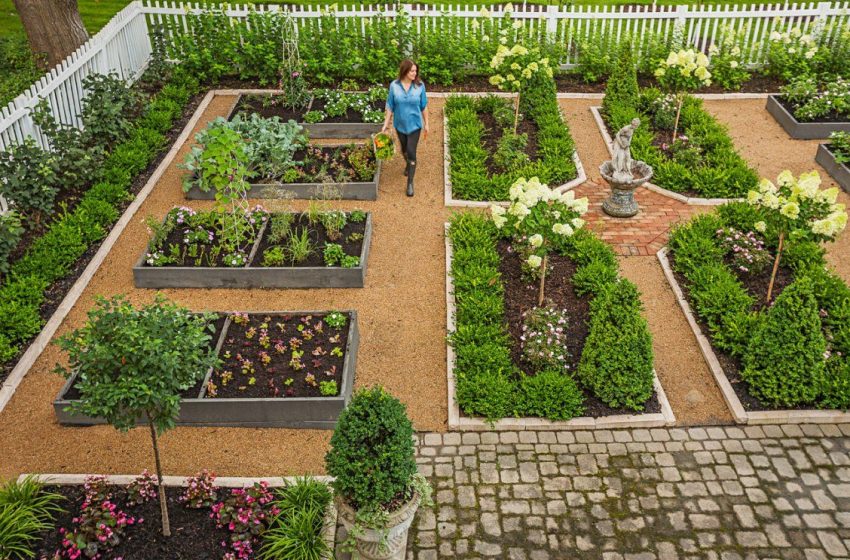Front yard vegetable garden ideas: Grow a mix of food and flowers

Wish you could grow veggies, but your backyard is in complete shade? Or perhaps it’s taken up by a deck or laid out with a play for kids? Why not plan a front yard vegetable garden? With attitudes changing towards what a front yard should look like, more and more green thumbs are taking advantage of that valuable space and planting food. Oftentimes, the front yard presents the better option for growing fruit, vegetables, and herbs, because it offers perfect growing conditions.
That doesn’t mean the garden has to take up the whole lawn. You could tuck a small raised bed in an established perennial garden, for example. Or simply dig in vegetables in the spaces usually reserved for annuals. In this article, I share a few ideas to add a front yard vegetable garden to your yard.

Before drawing up a garden plan, you should consider a few key points:
- Bylaws: Are there bylaws or HOA laws that will influence your plans?
- Light: For heat-loving veggies, like tomatoes, melons, cucumbers, and peppers, your space needs to get at least eight to 10 hours of sun a day. You can get away with less for shade veggies.
- Soil: This may need to be heavily amended with organic matter. It can be done over time, but a solution is to garden in pots or raised beds, so you can control the soil in your garden. If you’re adding raised beds, you may also need a sizeable soil delivery to fill them.
- Upkeep: Do you have time for weeding? You may feel extra compelled to keep a neat and tidy garden because of it being more visible than if it were in the backyard.
- Water source: Will it be easy to navigate your hose to the front garden? If not, are you okay lugging watering cans around every morning in the summer?
- Call before you dig: Unless you’re adding plants to an established garden, it’s important that you know what’s underground (such as gas lines) before you start digging everything up. Most utility companies will come and mark the lines for free.
Planning your front yard vegetable garden
Before ripping everything out with abandon, consider how many veggies you’d like to grow. Perhaps you can carve out a garden and still keep a bit of lawn, or start up a small garden surrounded by flowers. There are so many options. But getting organized with a clear garden plan will allow you to figure the steps. You may want to start small and expand over time.
One main issue that you might not think about in your backyard is how your front yard veggie layout looks from the street. I’m happy that traditional ideas around curb appeal are changing, but it’s still a good idea to work with a plan to create an eye-catching, tidy garden.

My latest book, Gardening Your Front Yard, Projects and Ideas for Big & Small Spaces delves into a few front yard vegetable garden ideas, among others. You might consider finding a garden designer who specializes in kitchen gardens or incorporating veggie gardens in their drawings.
Sneaking front yard veggies into a perennial garden
If you don’t have the space to devote to a vegetable garden, work with what you have! Instead of adding your usual border of annuals, plant some herbs or greens. My neighbour plants beans in half barrels each year in his front garden, a lovely terraced landscape full of colourful perennials. Between the plant supports and the bean flowers, they are very ornamental.If you have a collection of ornamental pots that you plant up each year, choose herbs for the foliage plants and maybe sneak in a patio variety tomato or pepper. Maybe devote a few pots just to food, like a self-pollinating berry plant.

Adding raised beds to your front yard
I have seen more and more front yards with a collection of raised beds in place of the lawn. While chatting with Niki about front yard gardens, she recommended creating a space that’s both beautiful and productive, such as a couple of raised beds joined by a garden arch or a four-square kitchen garden with veggies and herb.Assess the area where you’d like to add a raised bed (or two, or three). It may be as easy as laying down some cardboard and mulch over the grass and installing your finished DIY gardens. But it could also require dealing with issues pertaining to a slope or drainage. Consult a professional if you plan to do doing anything that will change the grade of your property or affect runoff from heavy storms.




Leave a Reply